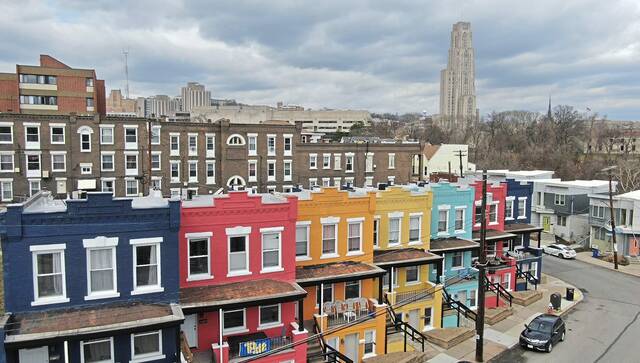https://triblive.com/local/pittsburgh-city-council-approaching-deadline-to-vote-on-proposed-oakland-zoning-changes/
Pittsburgh City Council approaching deadline to vote on proposed Oakland zoning changes

Pittsburgh City Council has until next week to vote on a controversial package of proposed zoning changes in Oakland or else the monthslong rezoning process would need to start over.
Members of the Oakland community have been largely divided over the proposed zoning changes.
The Planning Commission has already approved two 30-day extensions, but time expires for council to vote on the legislation next week, said Kate Rakus with the Department of City Planning.
If council does not act by then, it would be classified as a “deemed denial” and the entire process would need to restart, said Corey Layman, the city’s zoning administrator.
The legislation would create three new base zoning districts for portions of Oakland.
The proposed Urban Center-Employment district would allow a range of commercial uses and multi-unit residential housing, but only if all housing units were affordable for lower-income residents and housing didn’t make up more than half of a property’s gross square footage.
The proposed Urban Center-Mixed Use district would allow a range of commercial and residential uses, while the Residential-Mixed Use district would allow some smaller-scale commercial uses in addition to housing.
The zoning package also includes a measure that would expand inclusionary zoning into Oakland. That would require housing developments with 20 or more units to have at least 10% of their units designated as affordable housing. Inclusionary zoning already was approved in Lawrenceville, Bloomfield and Polish Hill.
City leaders have already attempted to strike compromises to make the zoning changes more popular for Oakland residents and stakeholders, though the changes don’t seem to be making many people happy.
In June, City Council approved a zoning amendment to clear the way for a controversial Walnut Capital development called Oakland Crossings. Since then, however, the measure has been tweaked and the legislation now before City Council would shrink building sizes that had previously been allowed.
The length of buildings in Urban Center-Mixed Use areas were initially planned to be capped at 400 feet. Now, the zoning proposal before City Council would shrink that to 250 feet, with an exception for grocery stores, which could still stretch to 400 feet.
Millie Sass, an Oakcliffe resident who has been vocal in her opposition to the proposed zoning changes, said she feels the plan still “allows extreme heights and lengths.”
“While we appreciate the lengths being reduced from 400 to 250 feet, it’s still too long, as 250 feet is the length of a city block,” added Elaina Zaitsoff, vice president of the Oakcliffe Community Organization.
She said she feared her neighborhood would be “walled in” by larger buildings that would be permitted under the proposed zoning package.
David Vatz, who spoke on behalf of Pro Housing Pittsburgh, said his organization would like to see larger buildings that could lead to more housing.
“We encourage them to allow greater heights, especially for residential uses,” he said, arguing that some elements of the proposed zoning were “too restrictive” for developers to build much-needed housing in the area.
Resident Vlad Kaplun also said he’d like to see larger building sizes allowed to clear the way for greater housing density.
“There are a lot of jobs in Oakland, and being able to live near your job is an incredible quality-of-life boost,” he said.
Representatives from the University of Pittsburgh and Carlow University said they were concerned that a portion of the legislation would limit educational-use space. The legislation would allow no more than 50% of a building in Urban Center-Employment areas to be used for educational purposes.
James Williams, senior director for city and county government relations at the University of Pittsburgh, said the school would like to see that number increased to 80%. He also highlighted the university’s worries that limiting buildings to 250 feet long is “far too restrictive” for developments the university had been planning.
Andrea Boykowycz, interim director of the Oakland Planning and Development Corp., said she was unhappy with allowing any educational space in Urban Center-Employment areas, arguing that would create a “backdoor” for universities to expand into other parts of the neighborhood beyond their campuses.
During a public hearing Monday, council members also heard concerns about whether reduced parking requirements for new developments would impact parking availability for residents and what the changes would mean for historic neighborhoods and structures.
Several residents also have complained that they felt left out of the process or were unhappy with elements of public engagement. Karen Brean, a planning consultant for Walnut Capital, said revisions to the legislation “have lacked rationale” and been inconsistent with regulations elsewhere in the city.
“Much care has been taken during the Oakland Plan to bring the public along,” Brean said. “That same care has not been taken with the zoning change process.”
Maps available online to showcase how the new zoning would work, she said, are “confusing at best, misleading at worst.”
“I don’t think anyone can say that the result of these labors has created a product that pleases anyone, let alone everyone,” said Jonathan Kamin, an attorney for Walnut Capital.
Copyright ©2025— Trib Total Media, LLC (TribLIVE.com)
